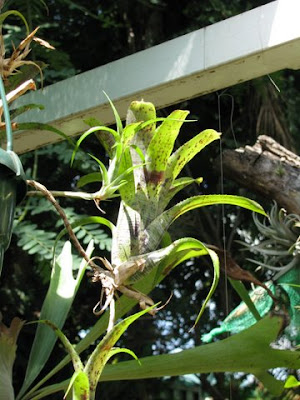Tropical farms is a nursery specializing in tropical plants including ferns, treeferns, orchids, palms, cycads, bromeliads and plateceriums to name a few. The blog contains over 3 thousand photos of rare and unique tropical plants!
Tuesday, February 15, 2011
Bromeliads of many different colors
Bromeliaceae (the bromeliads) is a family of monocot flowering plants of around 3,170 species native mainly to the tropical Americas, with a few species found in the American subtropics and one in tropical west Africa, Pitcairnia feliciana.[1] It is one of the basal families within the Poales and is unique because it is the only family within the order that has septal nectaries and inferior ovaries.[2] These inferior ovaries characterize the Bromelioideae, a subfamily of the Bromeliaceae.[3] The family includes both epiphytes, such as Spanish moss (Tillandsia usneoides), and terrestrial species, such as the pineapple (Ananas comosus). Many bromeliads are able to store water in a structure formed by their tightly-overlapping leaf bases. However, the family is diverse enough to include the tank bromeliads, grey-leaved epiphytic Tillandsia species that gather water only from leaf structures called trichomes, and a large number of desert-dwelling succulents.
The largest bromeliad is Puya raimondii, which reaches 3–4 m tall in vegetative growth with a flower spike 9–10 m tall, and the smallest is probably Spanish moss.
Bromeliads are one of the more recent plant groups to have emerged. The greatest number of primitive species reside in the Andean highlands of South America where they originated in the tepuis of the Guyana Shield.[4] The most basal genus Brocchinia is endemic to these tepuis and is placed as the sister group to the remaining genera in the family.[5] The west African species Pitcairnia feliciana is the only bromeliad not endemic to the Americas, and is thought to have reached Africa via long-distance dispersal approximately 12 million years ago.[4]
Humans have been using bromeliads for thousands of years. The Incas, Aztecs, Maya and others used them for food, protection, fiber and ceremony, just as they are still used today. European interest began when Spanish conquistadors returned with pineapple, which became so popular as an exotic food that the image of the pineapple was adapted into European art and sculpture. In 1776, the species Guzmania lingulata was introduced to Europe, causing a sensation among gardeners unfamiliar to such a plant. In 1828, Aechmea fasciata was brought to Europe, followed by Vriesea splendens in 1840. These transplants were successful enough that they are still among the most widely grown bromeliad varieties.
In the 19th century, breeders in Belgium, France and the Netherlands started hybridizing plants for wholesale trade. Many exotic varieties were produced up until World War I, which halted breeding programs and led to the loss of some species. The plants experienced a resurgence of popularity after World War II. Since then, Dutch, Belgian and North American nurseries have largely expanded bromeliad production.
(Wikipedia, http://en.wikipedia.org/wiki/Bromeliaceae, Accessed Oct 2011)
Bromeliads of many different colors. Who needs flowers anyways?
The largest bromeliad is Puya raimondii, which reaches 3–4 m tall in vegetative growth with a flower spike 9–10 m tall, and the smallest is probably Spanish moss.
Bromeliads are one of the more recent plant groups to have emerged. The greatest number of primitive species reside in the Andean highlands of South America where they originated in the tepuis of the Guyana Shield.[4] The most basal genus Brocchinia is endemic to these tepuis and is placed as the sister group to the remaining genera in the family.[5] The west African species Pitcairnia feliciana is the only bromeliad not endemic to the Americas, and is thought to have reached Africa via long-distance dispersal approximately 12 million years ago.[4]
Humans have been using bromeliads for thousands of years. The Incas, Aztecs, Maya and others used them for food, protection, fiber and ceremony, just as they are still used today. European interest began when Spanish conquistadors returned with pineapple, which became so popular as an exotic food that the image of the pineapple was adapted into European art and sculpture. In 1776, the species Guzmania lingulata was introduced to Europe, causing a sensation among gardeners unfamiliar to such a plant. In 1828, Aechmea fasciata was brought to Europe, followed by Vriesea splendens in 1840. These transplants were successful enough that they are still among the most widely grown bromeliad varieties.
In the 19th century, breeders in Belgium, France and the Netherlands started hybridizing plants for wholesale trade. Many exotic varieties were produced up until World War I, which halted breeding programs and led to the loss of some species. The plants experienced a resurgence of popularity after World War II. Since then, Dutch, Belgian and North American nurseries have largely expanded bromeliad production.
(Wikipedia, http://en.wikipedia.org/wiki/Bromeliaceae, Accessed Oct 2011)
Bromeliads of many different colors. Who needs flowers anyways?
Tillandsias on Royal Palm
This display of Tillandsias and Orchids has been done on the stem of a
Roystonea Regia with great effect.
Roystonea Regia with great effect.
Subscribe to:
Comments (Atom)

















































